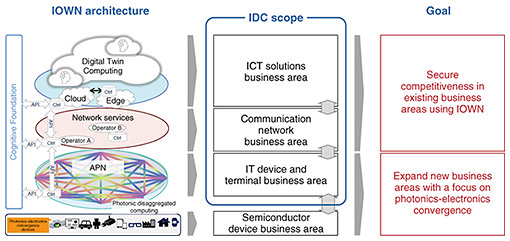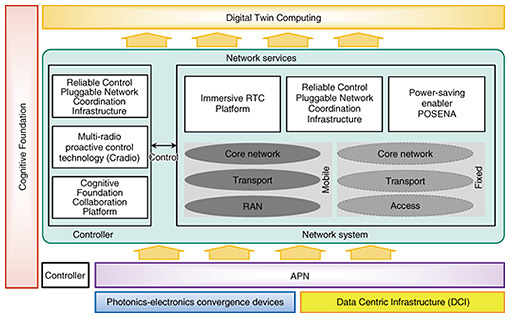 |
|||||||||||||||||||||
|
|
|||||||||||||||||||||
|
Feature Articles: Fixed-mobile Convergence Services with IOWN Vol. 23, No. 1, pp. 15–21, Jan. 2025. https://doi.org/10.53829/ntr202501fa1 Activities for Fixed-mobile Convergence Services in the IOWN InitiativeAbstractThe IOWN Product Design Center within the NTT IOWN Integrated Innovation Center formulates and drives development and dissemination strategies for the implementation of a fixed-mobile convergence network, which provides seamless and highly experiential end-to-end communications, allowing users access without any requirement that they be aware of the access method or the type of terminal used, whether mobile or fixed. We are also studying how the All-Photonics Network, a key technology in the Innovative Optical and Wireless Network (IOWN) initiative, applies to network services and the creation of new value. Keywords: IOWN, mobile, APN 1. Activities for fixed-mobile convergence in the IOWN initiative1.1 The IOWN initiative and activities of the IOWN Integrated Innovation CenterThe Innovative Optical and Wireless Network (IOWN) initiative aims to establish a new information and telecommunications infrastructure that will revolutionize information and telecommunications systems and overcome the limitations of current information and communication technology (ICT). IOWN is based on three main technologies: the All-Photonics Network (APN), which uses photonics-based technologies to provide end-to-end optical wavelength paths for everything from terminals to networks; Digital Twin Computing, which makes future prediction possible by combining the real and digital worlds; and the Cognitive Foundation, which connects and controls all ICT resources. The APN transmits optical data from terminals to the network without electrical conversion, enabling end-to-end transmission with remarkably low power consumption, high quality, high capacity, and low latency, properties difficult to achieve with current electronics-based technologies. Digital Twin Computing reproduces real-world objects as digital twins in a computer and makes future prediction and optimization possible by combining digital twins with one another and with the real world. The Cognitive Foundation harmonizes all ICT resources in a globally optimal manner and optimally controls various ICT resources including clouds, edges, networks, and terminals. Using these technologies, we will distribute and process information that encompasses a wide range of values equitably and in real time. Our aim is to improve the quality of “connections” between people and between people and society, helping to create a fulfilling society. The NTT IOWN Integrated Innovation Center aims to strengthen its research and development (R&D) capabilities to implement the 6th-generation mobile communications system (6G) and IOWN. It also seeks to be a game changer in the technology world and resuscitate the technical power of Japan by bringing together and integrating the technologies that it has cultivated in various fields, such as component development, network configuration, and software platform technology. Driven by the spread of ICT, globalization is accelerating, and the network and information processing infrastructure is gaining in importance. Considering that it is essential to collaborate with global vendors, we accelerate R&D by fully taking advantage of collaborative development within the IOWN Global Forum (IOWN GF) and with individual vendors. The NTT IOWN Integrated Innovation Center will provide new value to the world through R&D that brings together advanced technologies. The IOWN Product Design Center (IDC) formulates development and dissemination strategies that are back-cast from future market needs and social demands. On the basis of these strategies, it consistently pursues a range of activities, from technology development to dissemination and supporting introduction. Therefore, IDC is contributing to the early deployment of IOWN technology and implementation of services and products that use this technology (Fig. 1).
1.2 Activities that integrate a fixed-mobile convergence network with the IOWN APNIn the IOWN initiative, network services will be provided on a fixed-mobile convergence network that provides seamless, highly experiential end-to-end communications on high-bandwidth, low-latency, and low-power computing network resources and is agnostic regarding the access method, terminal used, and mobile or fixed usage. To implement fixed-mobile convergence, we are formulating a detailed plan for the application of the APN to network services. Specifically, we are studying the application of the APN to mobile operators’ 5G and 6G radio access network (RAN) systems to help address issues facing these operators and creating new value. In the future, 5G/6G RANs will use high-frequency bands such as the millimeter wave and sub-terahertz band. In such high-frequency bands, the coverage area of a single base station becomes smaller, necessitating the deployment of more base stations than before. The increase in the number of base stations gives rise to several issues, such as the increased power consumption of the entire mobile system and prolonged time required to construct all base stations. With the IOWN APN, we will contribute to lowering power consumption of the mobile system and shortening the base station construction period. 1.3 R&D for implementing a fixed-mobile convergence networkWe are defining network requirements for several use cases, such as metaverse, mobility as a service (MaaS), and multi-access edge computing (MEC)/virtualized RAN (vRAN), which will be widely deployed in the 6G/IOWN era, and undertaking R&D of technologies needed to satisfy these requirements. The R&D for the metaverse use case covers the provision of voice-and-video-based communication services, technology for reproducing the individuality of a non-player character (NPC) that speaks like the particular user in the virtual space of Digital Twin Computing, and mechanisms and security assurance to assist in economic activities that involve handling virtual currency in the virtual space. The R&D for the MaaS use case will start with ways to ensure stable wireless communications in which slow-speed devices are used in limited areas then ensure stable communications in urban areas or in moving buses or other vehicles at such a level that video images are not disrupted. We ultimately aim to implement a fixed-mobile convergence network in which high-definition video can be transmitted and received in fast-moving vehicles (or devices). For the MEC/vRAN use case, we aim to provide multi-access closed networks that combine mobile and fixed access networks and use an orchestrator to provide end-to-end network services, encompassing not only mobile and fixed access networks but also transport and core networks that satisfy given service requirements. 1.4 Products for the IOWN fixed-mobile convergence networkIOWN fixed-mobile convergence network services are implemented in two parts: a network system that provides sophisticated network functions and added value, and a controller that controls the network system in response to service requests (Fig. 2).
Network system-related products include the Reliable Control Pluggable Network Coordination Infrastructure [1], which securely connects users to clouds with high quality; Immersive Real-Time Communication (RTC) Platform [2], a new communications infrastructure that supports the metaverse, which may be provided on a mobile or fixed network; and POSENA (Power Saving ENAbler) [3], a software implementation technology intended for developers that enables power saving while meeting high-performance requirements with general-purpose servers. Controller-related products include products that implement multi-radio proactive control (Cradio®), a technology that creates a natural communications environment in which users need not be aware of the particular wireless network used; and the Cognitive Foundation Collaboration Platform [4], which automatically controls the sleep state of base stations on the basis of the amount of traffic they handle. We will continue to create characteristic use cases for 6G/IOWN and undertake R&D necessary for the convergence of mobile and fixed networks. We will also pursue R&D for space communications, such as a non-terrestrial network, as well as R&D and product development for the implementation of Cognitive Foundation. 2. Application of the IOWN APN to mobile fronthauls2.1 5G RAN configurationsThe 5G RAN consists of central units (CUs), distributed units (DUs) and radio units (RUs). The connection between a DU and RU is called a mobile fronthaul (MFH). An MFH can be configured in two different ways: centralized RAN (C-RAN) and distributed RAN (D-RAN). In the C-RAN configuration, both CUs and DUs are centrally deployed and controlled at the central office, and only RUs are deployed at the base stations. In the D-RAN configuration, both CUs and DUs, or only DUs are deployed at base stations in addition to RUs. C-RAN provides several benefits, including the statistical multiplexing effect of RAN devices, and advances in radio systems (advanced coordination and improved frequency utilization efficiency between cells through carrier aggregation, and increased capacity and communication stability through add-on cells). C-RAN is also highly compatible with virtualization of CUs and DUs, which can reduce costs and offer high scalability. However, MFHs need to meet stringent technical requirements of high capacity and low latency, as specified by the O-RAN ALLIANCE in Standard Specification Split Option 7-2x. Therefore, the deployment of optical fibers is important for the spread of C-RAN. While optical fiber is widely deployed in Japan and Korea, it is yet to be deployed on a large scale in other countries, where RAN configurations will lead to efficient use of optical fiber. 2.2 Three expected benefitsWe are studying the application of the APN to MFHs in the C-RAN configuration to achieve high capacity, low latency, and effective use of optical fibers (Fig. 3). Specifically, the APN is used to connect DUs and RUs. The application of the APN, which features high capacity and low latency, is expected to provide three benefits. The first is that wavelength-division multiplexing used in the APN enables effective use of optical fibers. Several communications between a DU and RU can be multiplexed on a single fiber. Therefore, an MFH can be configured efficiently. The second is that the application of the APN minimizes the lead time for constructing or expanding a base station. All it takes to add a new RU is to assign a new wavelength to the port of the new RU*1. There is no need to install a new optical fiber. The third is that power consumption does not increase even when the number of base stations increases. As the 5G RAN expands, the number of base stations will increase, which increases the power consumption of the devices that make up the RAN. We can reduce the power consumption of the entire network that makes up the RAN by dynamically connecting and disconnecting the wavelength paths of the APN in response to the start and stop of the DUs/RUs, which depend on the time of day, in low-traffic areas.
2.3 Results of a demonstration experiment of applying the APN to an MFHWe conducted a demonstration experiment on the application of the APN to an MFH. In January 2024, NTT and Nokia successfully demonstrated an MFH in which paths can be dynamically changed using the APN [5]. We used the APN to connect a 5G RU to a DU and verified that the 5G RU and DU operated normally, including long-distance transmission of data. The APN device configuration and transmission method used in the experiment complied with the Proof of Concept (PoC) Reference [6] of the IOWN for mobile networks as defined by the IOWN GF. Assuming various APN device deployment configurations, we experimented with different distances between APN device sections (e.g., between the Open APN Transceiver (APN-T) and Open APN Gateway (APN-G), between the APN-G and Open APN Interchange (APN-I)) in long-distance transmission. Through this experiment, we confirmed that the RU and DU operated normally at a transmission distance of 25 km in various APN device deployment configurations: the quality of communications, such as the speed and loss rate of data transfer, was not affected*2, and that the latency was 133 μs (Fig. 4). We also confirmed that the latency of 133 μs enables long-distance transmission up to approximately 30 km*3.
2.4 Use case for MFH over APN (elastic load balancing)APN use cases are mainly studied by the IOWN GF. One of the use cases currently studied by the IOWN GF IOWN for Mobile Network Task Force is the use of elastic load balancing to reduce power consumption of mobile networks. The population of mobile network users in business areas is very large during the day and very small at night. In contrast, the user population in residential areas is small during the day and large at night. Most RAN systems in densely populated urban areas in Japan operate within a 10-km radius. Applying the APN to the transmission paths of these RAN systems can expand the RAN system coverage area. If the coverage area expands, it becomes possible to operate the mobile network with the optimal number of base stations, taking into consideration the population balance between zones with large daytime populations and those with small daytime populations. The APN’s wavelength-path switching (i.e., elastic load balancing) also enables efficient switching of connections between RUs and DUs. These operations and technologies lead to optimal performance and energy efficiency, resulting in low power consumption. 2.5 Future activities on MFH over APNWe have begun studying APN products for the future 6G era, which is expected to use high-frequency bands, such as the millimeter wave and sub-terahertz band, to achieve higher capacity. Because high-frequency bands exhibit higher attenuation than mid-band due to their frequency characteristics, radio waves cannot attain long distance. Therefore, more base stations will be required than before. To solve this problem, we are studying the utilization of analog radio-over-fiber technology [7] in transmission sections between RUs and antennas, and the application of the APN to these sections to use optical fibers effectively and create new value. Each mobile operator builds its own RAN facilities. As mentioned above, 6G will require many base stations, which will increase the cost of RAN facilities. To reduce the network costs incurred by mobile operators, we are studying ways to enable several operators to share antennas, APN transmission paths, etc., helping to promote the early spread of 6G.
References
|
|||||||||||||||||||||
















